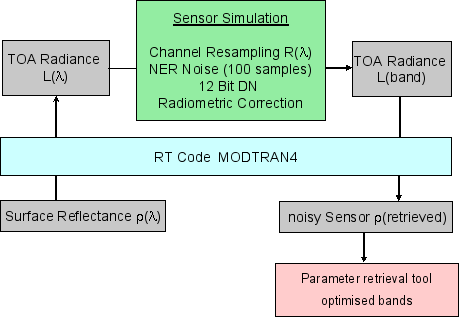Introduction
ESA is undertaking the development of the Sentinel-2, a super-spectral imaging mission for terrestrial applications. The mission is focusing on the continuity of LANDSAT and SPOT type measurements to provide operational information for the 'Global Monitoring of Environment and Security' (GMES). Sentinel-2 mission is currently under definition study and the mission and technical requirements can be found in the Mission Requirements Document (MRD) and System Requirements Document (SRD).
Objectives
The spectral molecular absorption and scattering properties of material form the basis for the identification and determination of the abundances of surface and atmospheric constituents. Accordingly, and in the context of distinct applications, this study (ESA-Contract: 19962/06/NL/EL) employs these fundamental spectral characteristics and their interdependence to spatial resolution and SNR as a basis for the detailed design and consolidation of spectral bands for the future Sentinel-2 sensors.
Assessment of the optimum spectral resolution configuration requires the simulation of spectra using different Sentinel-2 sensor variations. For this purpose a sensor simulation tool is designed. The Sentinel-2 sensor model is characterized by three major parameters: Several different and variable spectral response functions, the radiometric resolution (12 Bit) and noise equivalent radiance (NER) values. Using this tool, all meaningful sensor configurations are defined.
Each single sensor model is then used to calculate sensor specific reflectance data. The processing scheme of the reflectance retrieval model is depicted in Figure 1. The approach consists of several processing steps.

The selected input data consist of a spectral library containing synthetic, laboratory or field-measured reflectance spectra. In a first processing step, these spectra are converted to at-sensor radiance (L(α)) using pre-defined atmosphere and solar illumination conditions within the MODTRAN 4 radiative transfer code. The computed at-sensor radiance spectra (TOA) are then resampled to a set of spectral response functions imaging the variety of artificial Sentinel-2 sensors to be tested. Gaussian noise with the calculated NER amplitude is added to the spectra calculating several noisy variations per spectrum. In a further process these data are transferred to a 12 Bit radiometry followed by a radiometric correction. These data represents TOA sensor radiance data (L(band)). The simulation is completed by applying the MODTRAN 4-based atmospheric correction resulting in noisy sensor reflectance data. An optimum atmospheric correction using the same parameters as in the forward transformation is applied for the complete band definition process.
This tool allows the computation of synthetic Sentinel-2 spectra that form the frame for the subsequent data analysis. Most remote sensing applications require the use of specific band combinations and do not rely on single bands. The optimization is mainly driven by the spectral characteristics of vegetation constituents and minerals in the respective waveband regions and is performed separately for different applications in the following three wavelengths sections:
- Red Edge section (bands 4, 5, 6, 7, 8, and 8a)
- Visible Blue-Green section (bands 2 and 3)
- Short Wave Infrared section (bands 11 and 12)
The recommended band definitions are finally used to investigate the sensitivity of the system in regard to spectral stability requirements, radiometric requirements and an incorrect atmospheric correction.
A second work package comprises the assessment of the optimal spatial and spectral resolution configuration for the atmospheric correction bands of Sentinel-2 and is conducted by DLR. The involved spectral bands are the channels 1, 2, 4, 8a, 9, 10, and 12. In contrast to the previous investigations the atmospheric correction is excluded from the processing scheme and the spectral analysis is based on the sensor specific radiance data and a synthetic scene. The bands are optimized with regard to the retrieval of aerosols and water vapour as well as the detection of cirrus clouds.

